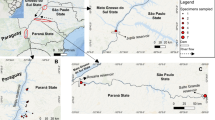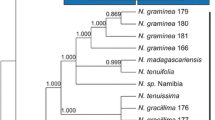Abstract
Nuclear ribosomal sequences and Cd, Zn, Pb and Fe accumulation of different populations of the recently discovered Cd/Zn-hyperaccumulating species Thlaspi praecox Wulfen (Noccaea) were studied to reveal their relationships to other representatives of the genus and especially to the well known hyperaccumulator T. caerulescens; comparisons of their accumulating properties were also made. Internal transcribed spacer (ITS) rDNA sequences from eight T. praecox populations from Slovenia showed 99% similarity and formed a sister group to T. caerulescens. Divergence estimates from the ITS rDNA support the origins of T. praecox in the Early Pleistocene, with further fragmentation of T. praecox populations in Slovenia since the Middle Pleistocene. Cd-hyperaccumulating features (>100 mg Cd kg−1 in the above-ground biomass) of T. praecox were seen for two populations collected at polluted sites (Žerjav and Mežica) and one population collected at a non-polluted site (Lokovec). The variability of the Cd concentrations in shoots was almost completely explained by the soil Cd concentrations, and were positively correlated with shoot Zn and Pb concentrations. The results from this molecular and metal accumulation characterisation of T. praecox populations provide new insights into the taxonomic affinities and accumulation potential of this hyperaccumulating species.



Similar content being viewed by others
References
Altschul SF, Madden TL, Schäffer AA, Zhang J, Zhang Z, Lipman DJ (1997) Gapped BLAST and PSI-BLAST: a new generation of protein database search programs. Nucleic Acids Res 25:3389–3402
Assunção AGL, Schat H, Aarts MG (2003a) Thlaspi caerulescens, an attractive model species to study heavy metal hyperaccumulation in plants. New Phytol 159:351–360
Assunção AGL, Bookum WM, Nelissen HJM, Vooijs R, Schat H, Ernst WHO (2003b) Differential metal-specific tolerance and accumulation patterns among Thlaspi caerulescens populations originating from different soil types. New Phytol 159:411–419
Basic N, Keller C, Fontanillas P, Vittoz P, Besnard G, Galland N (2006a) Cadmium hyperaccumulation and reproductive traits in natural Thlaspi caerulescens populations. Plant Biol 8:64–72
Basic N, Salamin N, Keller C, Galland N, Besnard G (2006b) Cadmium hyperaccumulation and genetic differentiation of Thlaspi caerulescens populations. Biochem Sys Ecol 34:667–677
Baker AJM, Reeves RD, Hajar ASM (1994) Heavy metal accumulation and tolerance in British population of the metalophyte Thlaspi caerulenscens J. & C. Presl (Brassicaceae). New Phytol 127:61–68
Bennett KD (1997) Evolution and ecology: the pace of life. Cambridge University Press, Cambridge
Besnard G, Rubio R, Christin P-A, Vargas P (2009) Phylogenetics of Olea (Oleaceae) based on plastid and nuclear ribosomal DNA sequences: tertiary climatic shifts and lineage differentiation times. Ann Bot 104(1):143–160
Brooks RR, Lee J, Reeves RD, Jaffrè T (1977) Detection of nickeliferous rocks by analysis of herbarium specimens of indicator plants. J Geochemical Explorer 7:49–57
Brooks RR, Chambers MF, Nicks LJ, Robinson BH (1998) Phytomining. Trends Plant Sci 3:359–362
Drummond AJ, Rambaut A (2007) BEAST: Bayesian evolutionary analysis by sampling trees. BMC Evolut Biol 7:214
Escarré J, Lefèbvre C, Gruber W, Leblanc M, Lepart J, Rivière Y, Delay B (2000) Zinc and cadmium hyperaccumulation by Thlaspi caerulescens from metalliferous and nonmetalliferous sites in the Mediterranean area: implication for phytoremediation. New Phytol 145:429–437
Felsenstein J (1988) Phylogenies from molecular sequences: inference and reliability. Ann Rev Genet 22:521–565
Hewitt G (2000) The genetic legacy of the Quaternary ice ages. Nature 405:907–913
Jimenez-Ambriz G, Petit C, Bourrie I, Dubois S, Olivieri I, Rouce O (2007) Life history variation in the heavy metal tolerant plant Thlaspi caerulescens growing in a network of contaminated and noncontaminated sites in southern France: role of gene flow, selection and phenotypic plasticity. New Phytol 173:199–215
Keller C, Diallo S, Cosio C, Basic N, Galland N (2006) Cadmium tolerance and hyperaccumulation by Thlaspi caerulescens populations grown in hydroponics are related to plant uptake characteristics in the field. Funct Plant Biol 33:673–684
Kimura M (1980) A simple method for estimating evolutionary rate of base substitutions through comparative studies of nucleotide sequences. J Molec Evol 16:111–120
Koch M, Mummenhoff K (2001) Thlaspi s.str. (Brassicaceae) versus Thlaspi s.l.: morphological and anatomical characters in the light of ITS nrDNA sequence data. Plant Syst Evol 227:209–225
Koch M, Al-Shehbaz IA (2004) Taxonomic and phylogenetic evaluation of the American “Thlaspi” species: identity and relationship to the Eurasian genus Noccaea (Brassicaceae). Syst Botany 29:375–384
Koch M, Dobeš C, Mitchell-Olds T (2003) Multiple hybrid formation in natural populations: concerted evolution of the internal transcribed spacer of nuclear ribosomal DNA (ITS) in North American Arabis divaricarpa (Brassicaceae). Mol Biol Evol 20:338–350
Kropf M, Kadereit JW, Comes HP (2003) Differential cycles of range contraction and expansion in European high mountain plants during the Late Quaternary: insights from Pritzelago alpina (L.) O. Kuntze (Brassicaceae). Mol Ecol 12:931–949
Lombi E, Zhao FJ, Dunham SJ, McGrath SP (2000) Cadmium accumulation in populations of Thlaspi caerulescens and Thlaspi goesingense. New Phytol 145:11–20
Larkin MA, Blackshields G, Brown NP, Chenna R, McGettigan PA, McWilliam H, Valentin F, Wallace IM, Wilm A, Lopez R, Thompson JD, Gibson TJ, Higgins DG (2007) Clustal W and Clustal X version 2.0. Bioinformatics 23:2947–2948
Marschner H (1995) Mineral nutrition of higher plants. Academic, London
Martinčič A, Wraber T, Jogan N, Podobnik A, Turk B, Vreš B, Ravnik V, Frajman B, Strgulc Krajšek S, Trčak B, Bačič T, Fischer MA, Eler K, Surina B (2007) Mala flora Slovenije. Tehniška založba Slovenije, Ljubljana
Meyer FK (1973) Conspectus der “Thlaspi” Arten Europas, Afrikas und Vorderasien. Feddes Repertorium 84:449–470
Meyer FK (1979) Kritische Revison der “Thlaspi” Arten Europas, Afrikas und Vorderasien. Feddes Repertorium 90:129–154
Mills RF, Krijger GC, Baccarini PJ, Hall JL, Williams LE (2003) Functional expression of AtHMA4, a P1B-type ATPase of the Zn/Co/Cd/Pb subclass. Plant J 35:164–176
Mills RF, Franci A, Ferreira da Rocha PS, Baccarini PJ, Aylett M, Krijger GC, Williams LE (2005) The plant P1B-type ATPase AtHMA4 transports Zn and Cd and plays a role in detoxification of transition metals supplied at elevated levels. FEBS Lett 579:783–791
Molitor M, Dechamps C, Gruber W, Meerts P (2005) Thlaspi caerulescens on nonmetalliferous soil in Luxembourg: ecological niche and genetic variation in the mineral element composition. New Phytol 165:503–512
Mummenhoff K, Zunk K (1991) Should Thlaspi (Brassicaceae) be split? Preliminary evidence from isoelectric focusing analysis of Rubisco. Taxon 40:427–434
Mummenhoff K, Koch M (1994) Chloroplast DNA restriction site variation and phylogenetic relationships in the genus Thlaspi sensu lato (Brassicaceae). Syst Botany 19:73–88
Mummenhoff K, Franzke A, Koch M (1997) Molecular phyogenetics of Thlaspi s.l. (Brassicaceae) based on chloroplast DNA restriction site variation and sequences of the internal transcribed spacers of nuclear ribosomal DNA. Can J Bot 75:469–482
Peer WA, Mamoudian M, Lahner B, Reeves RD, Murphy AS, Salt DE (2003) Identifying model metal hyperaccumulating plants: germplasm analysis of 20 Brassicaceae accessions from a wide geographical area. New Phytol 159:421–430
Peer WA, Mahmoudian M, Freeman JL, Lahner B, Richards EL, Reeves RD, Murphy AS, Salt DE (2006) Assessment of plants from the Brassicaceae family as a model for the study nickel and zinc hyperaccumulation. New Phytol 172:248–260
Pollard AJ, Powell KD, Harper FA, Andrew J, Smith C (2002) The genetic basis of metal hyperaccumulation in plants. Crit Rev Plant Sci. 21:539–566
Pongrac P, Vogel-Mikuš K, Kump P, Nečemer M, Tolrà R, Poschenrieder C, Barceló J, Regvar M (2007) Changes in elemental uptake and arbuscular mycorrhizal colonisation during the life cycle of Thlaspi praecox Wulfen. Chemosphere 69:1602–1609
Pongrac P, Zhao FJ, Razinger J, Zrimec A, Regvar M (2009) Physiological responses to Cd and Zn in two Cd/Zn hyperaccumulating Thlaspi species. Environ Exp Bot 66:479–486
Posada D, Crandall KA (1998) Modeltesst: testing the model of DNA substitution. Bioinformatics 14:817–818
Reeves RD (1988) Nickel and zinc accumulation by species of Thlaspi L., Cochlearia L., and other genera of Brassicaceae. Taxon 37:309–318
Reeves RD, Brooks RR (1983) Hyperaccumulation of lead and zinc by two metallophytes from mining areas of central Europe. Environ Pollut A 31:277–285
Reeves RD, Baker AJM (2000) Metal accumulating plants. In: Raskin I, Ensley BD (eds) Phytoremediation of toxic metals: using plants to clean up the environment. Wiley, New York, pp 193–229
Reeves RD, Schwartz C, Morel JL, Edmonds J (2001) Distribution and metal-accumulating behaviour of Thlaspi caerulescens and associated metallophytes in France. Inter J Phytoremediation 3:145–172
Robinson BH, Leblanc M, Petit D, Brooks RR, Kirkman JH, Gregg PEH (1998) The potential of Thlaspi caerulescens for phytoremediation of contaminated soils. Plant Soil 203:47–56
Ronquist F, Huelsenbeck JP (2003) MRBAYES 3: Bayesian phylogenetic inference under mixed models. Bioinformatics 19:1572–1574
Roosens N, Verbruggen N, Meerts P, Ximénez-Embún P, Smith JAC (2003) Natural variation in cadmium tolerance and its relationship to metal hyperaccumulation for seven populations of Thlaspi caerulescens from Western Europe. Plant Cell Environ 26:1657–1672
Rutherford S, D’Hondt S (2000) Early onset and tropical forcing of 100 000-year Pleistocene glacial cycles. Nature 408:72–75
Sanderson MJ (1998) Estimating rate and time in molecular phylogenies: beyond the molecular clock? In: Soltis DE, Soltis PS, Doyle JJ (eds) Molecular systematics of plants II: DNA sequencing. Kluwer, Dordrecht, pp 242–264
Schat H, Llugany M, Bernhard R (2000) Metal specific patterns of tolerance, uptake, and transport of heavy metals in hyperaccumulating and nonhyperaccumulating metallophytes. In: Terry N, Bañuelos GS (eds) Phytoremediation of contaminated soil and water. Lewis, Boca Raton, pp 171–188
Swofford DL (2003) PAUP*. Phylogenetic analysis using parsimony (*and other methods). Version 4. Sinauer Associates, Sunderland
Taberlet P, Fumagalli L, Wust-Saucy A-G, Cosson J-F (1998) Comparative phylogeography and postglacial colonization routes in Europe. Molec Ecol 7:453–464
Vogel-Mikuš K, Drobne D, Regvar M (2005) Zn, Cd and Pb accumulation and arbuscular mycorrhizal colonisation of pennycress Thlaspi praecox Wulf. (Brassicaceae) from the vicinity of a lead mine. Environ Pollut 133:233–242
Vogel-Mikuš K, Pongrac P, Kump P, Nečemer M, Regvar M (2006) Colonisation of a Zn, Cd and Pb hyperaccumulator Thlaspi praecox Wulfen with indigenous arbuscular mycorrhizal fungal mixture induces changes in heavy metal and nutrient uptake. Environ Pollut 139:362–371
Vogel-Mikuš K, Regvar M, Mesjasz-Przybyłowicz J, Przybyłowicz WJ, Simčič J, Pelicon P, Budnar M (2008a) Spatial distribution of cadmium in leaves of metal hyperaccumulating Thlaspi praecox using micro-PIXE. New Phytol 179:712–721
Vogel-Mikuš K, Simčič J, Pelicon P, Budnar M, Kump P, Nečemer M, Mesjasz-Przybyłowicz J, Przybyłowicz WJ, Regvar M (2008b) Comparison of essential and non-essential element distribution in leaves of the Cd/Zn hyperaccumulator Thlaspi praecox as revealed by micro-PIXE. Plant Cell Environ 31:1484–1496
Xing JP, Jiang RF, Ueno D, Ma JF, Schat H, McGrath SP, Zhao FJ (2008) Variation in root-to-shoot translocation of cadmium and zinc among different accessions of the hyperaccumulators Thlaspi caerulescens and Thlaspi praecox. New Phytol 178:315–325
Wraber T (2005) O verjetni nesamoniklosti nekaterih semenk, primerov za florulo castrensis, v flori Sovenije (On the probable non-native occurrence of some spermatophytes, examples of the florula castrensis, in the flora Slovenia). Hladnikia 18:3–10
White TJ, Bruns T, Lee S, Taylor J (1990) Amplication and direct sequencing of fungal ribosomal RNA genes for phylogenetics. In: Innis MA, Gelfand DH, Sninsky JJ, White TJ (eds) PCR—protocols and applications—a laboratory manual. Academic, London, pp 315–322
Zunk K, Mummenhoff K, Koch M, Hurka H (1996) Phytogenetic relationships of Thlaspi s.l. (subtribe Thlaspidinae, Lepidieae) and allied genera based on chloroplast DNA restriction-site variation. Theor Appl Genet 92:375–381
Acknowledgements
The authors are indebted to Assoc. Prof. Dr. Damjana Drobne for access to the AAS for the element analysis. The work was supported by the following projects: MSZS P1-0212 Biology of Plants Research Programme, “Young researchers” and EU COST 859. A scholarship from the World Federation of Scientists and a National Fellowship awarded by L’OREAL-UNESCO-The Slovenian Science Foundation to P. Pongrac are gratefully acknowledged.
Author information
Authors and Affiliations
Corresponding author
Additional information
Responsible Editor: Henk Schat.
Rights and permissions
About this article
Cite this article
Likar, M., Pongrac, P., Vogel-Mikuš, K. et al. Molecular diversity and metal accumulation of different Thlaspi praecox populations from Slovenia. Plant Soil 330, 195–205 (2010). https://doi.org/10.1007/s11104-009-0192-x
Received:
Accepted:
Published:
Issue Date:
DOI: https://doi.org/10.1007/s11104-009-0192-x




